Jaewoong Cho
Distilling LLM Agent into Small Models with Retrieval and Code Tools
May 23, 2025Abstract:Large language models (LLMs) excel at complex reasoning tasks but remain computationally expensive, limiting their practical deployment. To address this, recent works have focused on distilling reasoning capabilities into smaller language models (sLMs) using chain-of-thought (CoT) traces from teacher LLMs. However, this approach struggles in scenarios requiring rare factual knowledge or precise computation, where sLMs often hallucinate due to limited capability. In this work, we propose Agent Distillation, a framework for transferring not only reasoning capability but full task-solving behavior from LLM-based agents into sLMs with retrieval and code tools. We improve agent distillation along two complementary axes: (1) we introduce a prompting method called first-thought prefix to enhance the quality of teacher-generated trajectories; and (2) we propose a self-consistent action generation for improving test-time robustness of small agents. We evaluate our method on eight reasoning tasks across factual and mathematical domains, covering both in-domain and out-of-domain generalization. Our results show that sLMs as small as 0.5B, 1.5B, 3B parameters can achieve performance competitive with next-tier larger 1.5B, 3B, 7B models fine-tuned using CoT distillation, demonstrating the potential of agent distillation for building practical, tool-using small agents. Our code is available at https://github.com/Nardien/agent-distillation.
T1: Tool-integrated Self-verification for Test-time Compute Scaling in Small Language Models
Apr 07, 2025Abstract:Recent studies have demonstrated that test-time compute scaling effectively improves the performance of small language models (sLMs). However, prior research has mainly examined test-time compute scaling with an additional larger model as a verifier, leaving self-verification by sLMs underexplored. In this work, we investigate whether sLMs can reliably self-verify their outputs under test-time scaling. We find that even with knowledge distillation from larger verifiers, sLMs struggle with verification tasks requiring memorization, such as numerical calculations and fact-checking. To address this limitation, we propose Tool-integrated self-verification (T1), which delegates memorization-heavy verification steps to external tools, such as a code interpreter. Our theoretical analysis shows that tool integration reduces memorization demands and improves test-time scaling performance. Experiments on the MATH benchmark demonstrate that, with T1, a Llama-3.2 1B model under test-time scaling outperforms the significantly larger Llama-3.1 8B model. Moreover, T1 generalizes effectively to both mathematical (MATH500) and multi-domain knowledge-intensive tasks (MMLU-Pro). Our findings highlight the potential of tool integration to substantially improve the self-verification abilities of sLMs.
Efficient Generative Modeling with Residual Vector Quantization-Based Tokens
Dec 13, 2024Abstract:We explore the use of Residual Vector Quantization (RVQ) for high-fidelity generation in vector-quantized generative models. This quantization technique maintains higher data fidelity by employing more in-depth tokens. However, increasing the token number in generative models leads to slower inference speeds. To this end, we introduce ResGen, an efficient RVQ-based discrete diffusion model that generates high-fidelity samples without compromising sampling speed. Our key idea is a direct prediction of vector embedding of collective tokens rather than individual ones. Moreover, we demonstrate that our proposed token masking and multi-token prediction method can be formulated within a principled probabilistic framework using a discrete diffusion process and variational inference. We validate the efficacy and generalizability of the proposed method on two challenging tasks across different modalities: conditional image generation} on ImageNet 256x256 and zero-shot text-to-speech synthesis. Experimental results demonstrate that ResGen outperforms autoregressive counterparts in both tasks, delivering superior performance without compromising sampling speed. Furthermore, as we scale the depth of RVQ, our generative models exhibit enhanced generation fidelity or faster sampling speeds compared to similarly sized baseline models. The project page can be found at https://resgen-genai.github.io
Lexico: Extreme KV Cache Compression via Sparse Coding over Universal Dictionaries
Dec 12, 2024



Abstract:We introduce Lexico, a novel KV cache compression method that leverages sparse coding with a universal dictionary. Our key finding is that key-value cache in modern LLMs can be accurately approximated using sparse linear combination from a small, input-agnostic dictionary of ~4k atoms, enabling efficient compression across different input prompts, tasks and models. Using orthogonal matching pursuit for sparse approximation, Lexico achieves flexible compression ratios through direct sparsity control. On GSM8K, across multiple model families (Mistral, Llama 3, Qwen2.5), Lexico maintains 90-95% of the original performance while using only 15-25% of the full KV-cache memory, outperforming both quantization and token eviction methods. Notably, Lexico remains effective in low memory regimes where 2-bit quantization fails, achieving up to 1.7x better compression on LongBench and GSM8K while maintaining high accuracy.
Latent Paraphrasing: Perturbation on Layers Improves Knowledge Injection in Language Models
Nov 01, 2024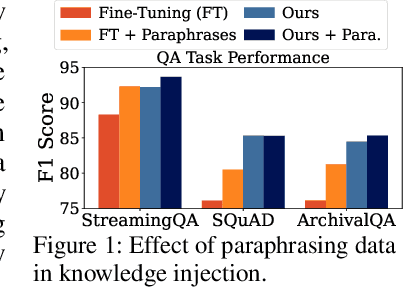

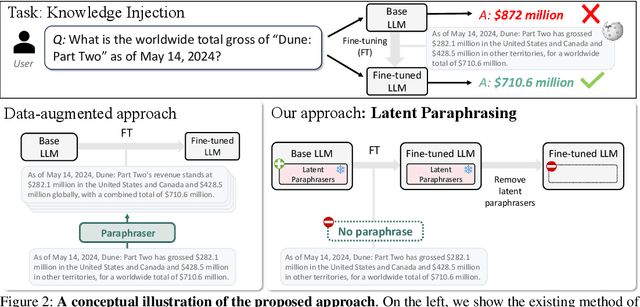

Abstract:As Large Language Models (LLMs) are increasingly deployed in specialized domains with continuously evolving knowledge, the need for timely and precise knowledge injection has become essential. Fine-tuning with paraphrased data is a common approach to enhance knowledge injection, yet it faces two significant challenges: high computational costs due to repetitive external model usage and limited sample diversity. To this end, we introduce LaPael, a latent-level paraphrasing method that applies input-dependent noise to early LLM layers. This approach enables diverse and semantically consistent augmentations directly within the model. Furthermore, it eliminates the recurring costs of paraphrase generation for each knowledge update. Our extensive experiments on question-answering benchmarks demonstrate that LaPael improves knowledge injection over standard fine-tuning and existing noise-based approaches. Additionally, combining LaPael with data-level paraphrasing further enhances performance.
Rare-to-Frequent: Unlocking Compositional Generation Power of Diffusion Models on Rare Concepts with LLM Guidance
Oct 29, 2024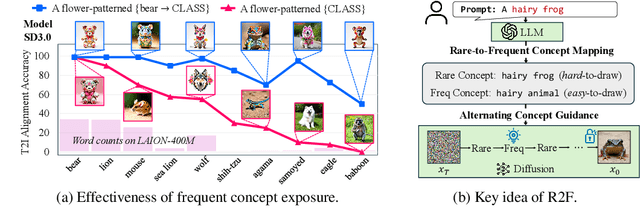



Abstract:State-of-the-art text-to-image (T2I) diffusion models often struggle to generate rare compositions of concepts, e.g., objects with unusual attributes. In this paper, we show that the compositional generation power of diffusion models on such rare concepts can be significantly enhanced by the Large Language Model (LLM) guidance. We start with empirical and theoretical analysis, demonstrating that exposing frequent concepts relevant to the target rare concepts during the diffusion sampling process yields more accurate concept composition. Based on this, we propose a training-free approach, R2F, that plans and executes the overall rare-to-frequent concept guidance throughout the diffusion inference by leveraging the abundant semantic knowledge in LLMs. Our framework is flexible across any pre-trained diffusion models and LLMs, and can be seamlessly integrated with the region-guided diffusion approaches. Extensive experiments on three datasets, including our newly proposed benchmark, RareBench, containing various prompts with rare compositions of concepts, R2F significantly surpasses existing models including SD3.0 and FLUX by up to 28.1%p in T2I alignment. Code is available at https://github.com/krafton-ai/Rare2Frequent.
Bridging the Gap between Expert and Language Models: Concept-guided Chess Commentary Generation and Evaluation
Oct 28, 2024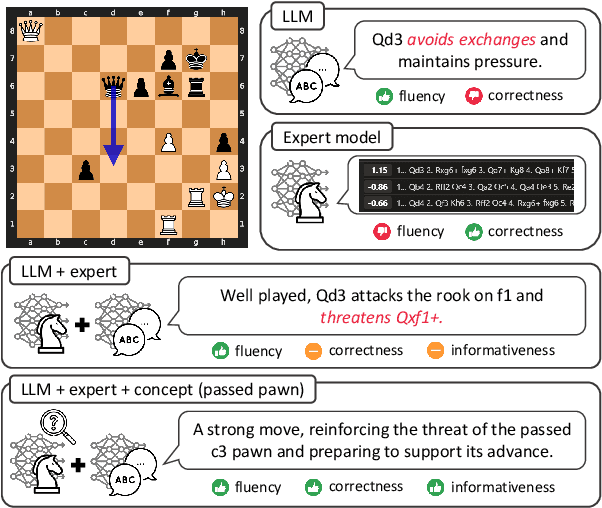

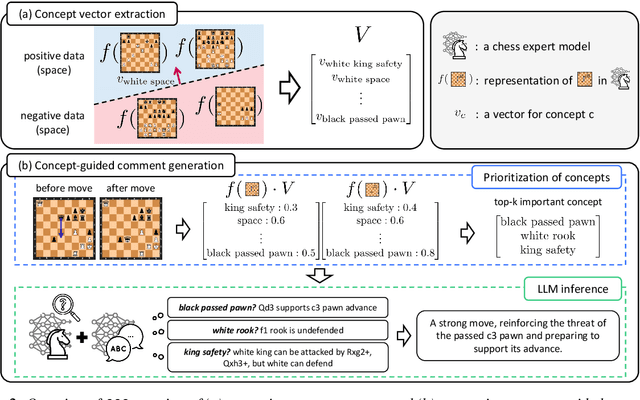

Abstract:Deep learning-based expert models have reached superhuman performance in decision-making domains such as chess and Go. However, it is under-explored to explain or comment on given decisions although it is important for human education and model explainability. The outputs of expert models are accurate, but yet difficult to interpret for humans. On the other hand, large language models (LLMs) produce fluent commentary but are prone to hallucinations due to their limited decision-making capabilities. To bridge this gap between expert models and LLMs, we focus on chess commentary as a representative case of explaining complex decision-making processes through language and address both the generation and evaluation of commentary. We introduce Concept-guided Chess Commentary generation (CCC) for producing commentary and GPT-based Chess Commentary Evaluation (GCC-Eval) for assessing it. CCC integrates the decision-making strengths of expert models with the linguistic fluency of LLMs through prioritized, concept-based explanations. GCC-Eval leverages expert knowledge to evaluate chess commentary based on informativeness and linguistic quality. Experimental results, validated by both human judges and GCC-Eval, demonstrate that CCC generates commentary that is accurate, informative, and fluent.
Fast and Accurate Neural Rendering Using Semi-Gradients
Oct 14, 2024
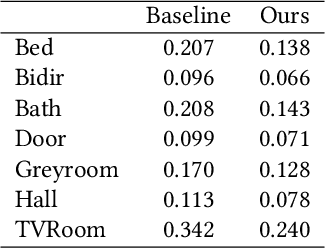
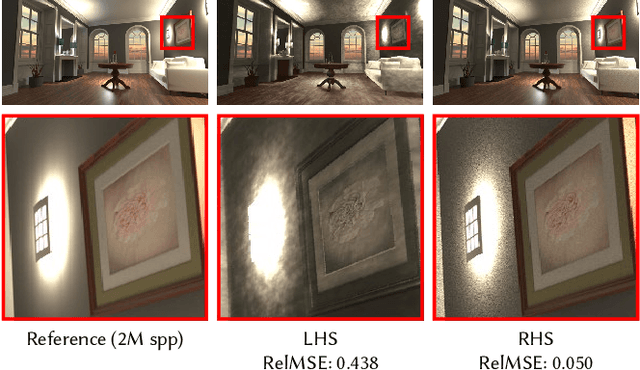
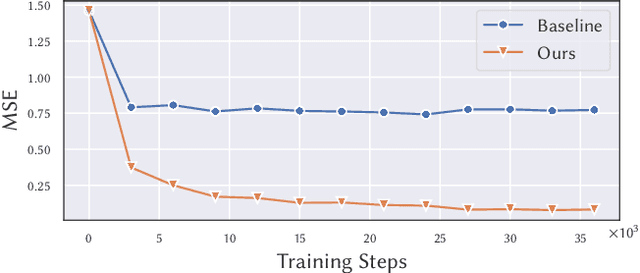
Abstract:We propose a simple yet effective neural network-based framework for global illumination rendering. Recently, rendering techniques that learn neural radiance caches by minimizing the difference (i.e., residual) between the left and right sides of the rendering equation have been suggested. Due to their ease of implementation and the advantage of excluding path integral calculations, these techniques have been applied to various fields, such as free-viewpoint rendering, differentiable rendering, and real-time rendering. However, issues of slow training and occasionally darkened renders have been noted. We identify the cause of these issues as the bias and high variance present in the gradient estimates of the existing residual-based objective function. To address this, we introduce a new objective function that maintains the same global optimum as before but allows for unbiased and low-variance gradient estimates, enabling faster and more accurate training of neural networks. In conclusion, this method is simply implemented by ignoring the partial derivatives of the right-hand side, and theoretical and experimental analyses demonstrate the effectiveness of the proposed loss.
Task Diversity Shortens the ICL Plateau
Oct 07, 2024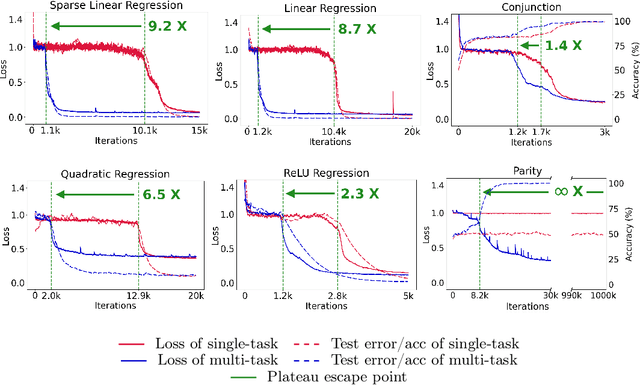



Abstract:In-context learning (ICL) describes a language model's ability to generate outputs based on a set of input demonstrations and a subsequent query. To understand this remarkable capability, researchers have studied simplified, stylized models. These studies have consistently observed long loss plateaus, during which models exhibit minimal improvement, followed by a sudden, rapid surge of learning. In this work, we reveal that training on multiple diverse ICL tasks simultaneously shortens the loss plateaus, making each task easier to learn. This finding is surprising as it contradicts the natural intuition that the combined complexity of multiple ICL tasks would lengthen the learning process, not shorten it. Our result suggests that the recent success in large-scale training of language models may be attributed not only to the richness of the data at scale but also to the easier optimization (training) induced by the diversity of natural language training data.
A Simple Early Exiting Framework for Accelerated Sampling in Diffusion Models
Aug 12, 2024Abstract:Diffusion models have shown remarkable performance in generation problems over various domains including images, videos, text, and audio. A practical bottleneck of diffusion models is their sampling speed, due to the repeated evaluation of score estimation networks during the inference. In this work, we propose a novel framework capable of adaptively allocating compute required for the score estimation, thereby reducing the overall sampling time of diffusion models. We observe that the amount of computation required for the score estimation may vary along the time step for which the score is estimated. Based on this observation, we propose an early-exiting scheme, where we skip the subset of parameters in the score estimation network during the inference, based on a time-dependent exit schedule. Using the diffusion models for image synthesis, we show that our method could significantly improve the sampling throughput of the diffusion models without compromising image quality. Furthermore, we also demonstrate that our method seamlessly integrates with various types of solvers for faster sampling, capitalizing on their compatibility to enhance overall efficiency. The source code and our experiments are available at \url{https://github.com/taehong-moon/ee-diffusion}
 Add to Chrome
Add to Chrome Add to Firefox
Add to Firefox Add to Edge
Add to Edge